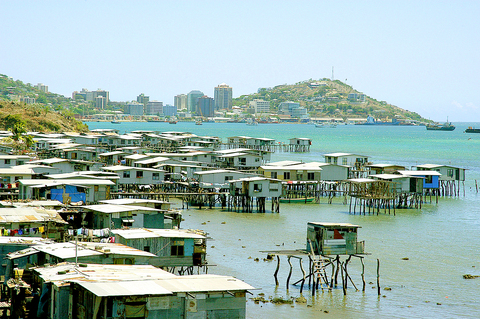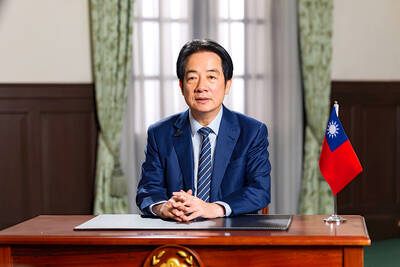Earlier this month, scientists reported that deep in the jungle-clad mountains of the island of New Guinea there is a "lost world." The finds weren't as dramatic as dinosaurs or man-eating plants, but there was a new bird, some frogs, butterflies and a few plants, all previously unknown to science. The expedition members dropped in on the Foja mountains by helicopter and explored an area untouched by humans. A "Garden of Eden," they called it.
It was an impressive discovery by today's standards, but a few decades ago such finds were commonplace.
Just 76 years ago, gold prospectors from Australia found unexplored land in the Highland mountains of what was then the Australian Territories of Papua and New Guinea. In 1930, the new life-form wasn't amphibious or avian, but human: thousands of people, previously uncontacted by the outside world.

PHOTO: AFP
The gold prospectors took a 16mm cine camera on their expedition. First Contact, the resulting crackly film, is still in circulation and makes for excellent viewing. As well as bemusement over the white men's wind-up gramophones, there was puzzlement over the heavy rucksacks their porters carried. What did they contain? This must be where the white men hid their wives.
The Melanesian Highlanders thought the Caucasian Australians were their ancestors returned from the dead. The white ghosts lapped up the reverence and persuaded the mere mortals to clear a runway for a "big bird" to land from the sky.
The Highlands have never been the same since. In came the gold miners, missionaries, doctors and administrative johnnies. Now there are even tourists. Wealthy Americans (mostly) visit New Guinea to experience a Discovery Channel-type vacation, spotting birds of paradise, or manipulating massive underwater cameras to photograph a rare, thumbnail-sized pygmy seahorse.
The reefs are some of the most pristine in the world, with some of the highest biodiversity. On the live-aboard dive-boat MV Chertan, I met an American who has dived more than 5,000 times in over 10 countries.
He rates Papua New Guinea's Milne Bay as "the best."
It is the highest island in the world and, culturally, the most diverse, with over 800 languages spoken. Tiny planes -- some belonging to the Missionary Aviation Fellowship -- carry paying passengers to precarious airstrips carved in jungles and mountain-sides. For the independent traveller, there are basic church guesthouses and a few village home-stays.
If you prefer more comfort but less authenticity, there is an African-style lodge 2,133m up above the tropical seas in the Southern Highlands. Ambua, with its round, kunai-grass-thatched chalets and communal dining room with cosy fireplace, is less than an hour's flight (or eight hours' drive) from the nearest town, Mount Hagen.
Up in the Southern Highlands, it rains for 300 days a year. The jungles are home to birds of paradise, dinner-plate-sized moths and, possibly, tree kangaroos. Near the lodge, there's a suspension bridge over a gorge made entirely from vines.
The local Huli people still wear traditional costume -- not just for tourist shows or annual gatherings, but to parade their importance or show respect.
Down on the sultry plains, where the mighty Sepik flows, there are tribes with initiation rites which involve hundreds of painful incisions, rubbed with river mud.
Here in the chilly Highlands, adolescent boys retreat into the jungle together for 18 months to attend a "wig school" where they learn to grow their hair. For a year and a half, the men stay away from women, exercise to develop a perfect physique and lavish much attention on their head. They sprinkle it three times a day with rainwater, sleep on a special wooden headrest and must not run for fear of spoiling their coif.
They also hunt for birds of paradise. They then cut off their locks and weave them into a headdress the shape of a bird's nest, decorated with feathers and flowers.
There is an explanation for this. The totem of the people from the riverine plain is a crocodile: with their new blistering welts, the men's skin looks reptilian. The totem of the Huli people is a bird of paradise: the men decorate themselves like the exotic birds.
There's nothing like a holiday in PNG to turn you into an anthropologist.
For your information:
Ecotourism Melanesia (em.com.pg) has village accommodation and guided treks.
Live-aboard dive boat: www.chertan.com.

This month the government ordered a one-year block of Xiaohongshu (小紅書) or Rednote, a Chinese social media platform with more than 3 million users in Taiwan. The government pointed to widespread fraud activity on the platform, along with cybersecurity failures. Officials said that they had reached out to the company and asked it to change. However, they received no response. The pro-China parties, the Chinese Nationalist Party (KMT) and Taiwan People’s Party (TPP), immediately swung into action, denouncing the ban as an attack on free speech. This “free speech” claim was then echoed by the People’s Republic of China (PRC),

Exceptions to the rule are sometimes revealing. For a brief few years, there was an emerging ideological split between the Democratic Progressive Party (DPP) and Chinese Nationalist Party (KMT) that appeared to be pushing the DPP in a direction that would be considered more liberal, and the KMT more conservative. In the previous column, “The KMT-DPP’s bureaucrat-led developmental state” (Dec. 11, page 12), we examined how Taiwan’s democratic system developed, and how both the two main parties largely accepted a similar consensus on how Taiwan should be run domestically and did not split along the left-right lines more familiar in

Many people in Taiwan first learned about universal basic income (UBI) — the idea that the government should provide regular, no-strings-attached payments to each citizen — in 2019. While seeking the Democratic nomination for the 2020 US presidential election, Andrew Yang, a politician of Taiwanese descent, said that, if elected, he’d institute a UBI of US$1,000 per month to “get the economic boot off of people’s throats, allowing them to lift their heads up, breathe, and get excited for the future.” His campaign petered out, but the concept of UBI hasn’t gone away. Throughout the industrialized world, there are fears that

The Democratic Progressive Party (DPP) controlled Executive Yuan (often called the Cabinet) finally fired back at the opposition-controlled Legislative Yuan in their ongoing struggle for control. The opposition Chinese Nationalist Party (KMT) and Taiwan People’s Party (TPP) acted surprised and outraged, but they should have seen it coming. Taiwan is now in a full-blown constitutional crisis. There are still peaceful ways out of this conflict, but with the KMT and TPP leadership in the hands of hardliners and the DPP having lost all patience, there is an alarming chance things could spiral out of control, threatening Taiwan’s democracy. This is no